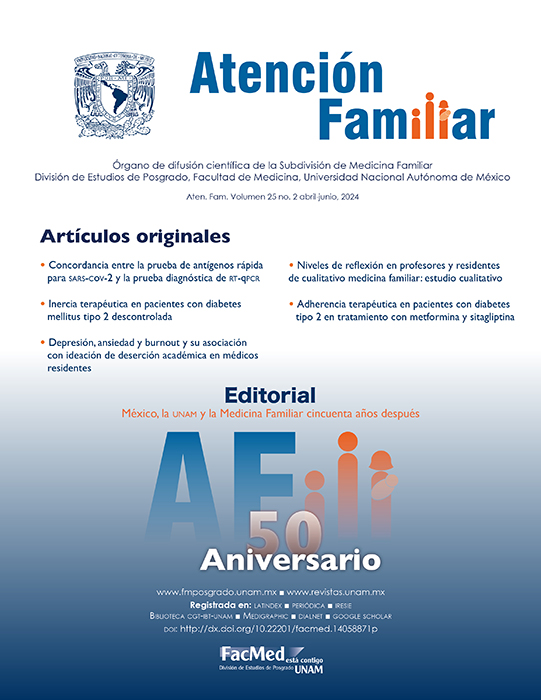Inercia terapéutica en pacientes con diabetes mellitus tipo 2 descontrolada
Main Article Content
Abstract
Objective: to analyze therapeutic inertia in patients with uncontrolled type 2 diabetes mellitus in a Family Medicine unit. Methods: analytical cross-sectional study conducted in a Family Medicine unit in Acapulco, Mexico. 255 records of uncontrolled patients with a diagnosis of type 2 diabetes mellitus were included, by non-probabilistic convenience sampling, from January to February 2023. The source of information was the medical record and laboratory database to obtain sociodemographic, clinical, anthropometric, and biochemical information. Medical records were reviewed to assess whether the physician changed the pharmacological treatment after the laboratory results. The seniority and training of the physician were obtained from the Coordination of Health Education and Research. Descriptive statistics, bivariate analysis by Mantel-Haenszel X2, and logistic regression were performed on the data obtained. A value of p<0.05 and 95% CI was considered statistically significant. Results: the incidence of therapeutic inertia (TI) was 85.9% (n= 219), 67.8% (n= 173) of the medical staff attended at least one face-to-face or online training course on diabetes mellitus. Being <60 years of age (ORa 2.99, 95% CI 1.40-6.39, p 0.002) increased the likelihood of therapeutic inertia. Conclusion: Eight out of ten patients with uncontrolled diabetes mellitus presented therapeutic inertia. It is important to raise awareness and promote an integral approach in which the patient, physician, and institution actively participate, and synergistically to achieve adequate metabolic control.
Downloads
Article Details
Citas en Dimensions Service
References
Instituto Mexicano del Seguro Social. Diagnóstico y tratamiento farmacológico de la Diabetes Mellitus Tipo 2 en el Primer Nivel de Atención. Guía de Evidencias y Recomendaciones: Guía de Práctica Clínica. México, IMSS; 2018.
Velasco-Contreras ME. Evolution of the type 2 diabetes mellitus epidemic in insured population at the IMSS. Rev Med Inst Mex Seg Soc. 2016;54(4):490- 503.
Federación Internacional de Diabetes. Atlas de la Federación Internacional de Diabetes. Décima edición. 2021.
Villalpando S, de la Cruz V, Rojas R, Shamah-Levy T, Avila MA, Gaona B, et al. Prevalence and distribution of type 2 diabetes mellitus in Mexican adult population: a probabilistic survey. Salud Publica Mex. 2010;52(1):19-26.
Basto-Abreu A, López-Olmedo N, Rojas-Martínez R, Aguilar-Salinas CA, Moreno-Banda GL, Carnalla M, et al. Prevalencia de prediabetes y diabetes en México: Ensanut 2022. Salud Publica Mex. 2023;65(1):163-168.
Instituto Mexicano del Seguro Social. Diagnóstico situacional de prevención y control de enfermedades 2019. 2019.
López-Simarro F. Inercia Terapéutica. Causas y soluciones. Hipertens riesgo vasc. 2012; 29:28-33.
Fundacion redGDPS. Suplemento extraordinario diabetes práctica. Inercia terapéutica en el tratamiento de la diabetes tipo 2. Fundación redGDPS.
García Morales G, Reyes Jiménez M. Inercia clínica en pacientes con diabetes mellitus tipo 2 en una unidad de medicina familiar de Acapulco Guerrero, México. Aten Fam. 2017;24(3):102-106.
Vázquez F, Lavielle P, Gómez-Díaz R, Wacher N. Inercia clínica en el tratamiento con insulina en el primer nivel de atención. México. Gac Med Mex. 2019; 155:161.
Flora López S. Inercia terapéutica en diabetes. Diabetes Práctica. 2014;05(02):49-96.
Martell CN, Franch J. Inercia e incumplimiento a partes iguales. Hipertens riesgo vasc. 2012;29(1):1-3.
Machado-Alba EJ. ¿Inercia clínica, que tanto nos afecta? Rev Med Risaralda. 2013;19(1):94-96.
Bralic-Lang V, Bergman-Markovic B, Kranjcevic K. Family Physician Clinical Inertia in Glycemic Control among Patients with Type 2 Diabetes. Med Sci Monit. 2015; 21:403-411.
Strain WD, Bluher M, Paldanius P. Clinical Inertia in Individualising Care for Diabetes: Is There Time to do More in Type 2 Diabetes? Diabetes Ther. 2014; 5:347-354.
Lopez-Simarro F, Brotons C, Moral I, Cols-Sagarra C, Selva A, Aguado-Jodar A, et al. Inertia and treatment compliance in patiets with type 2 diabetes in primary care. Med Clin. 2012;138(9):377-84.
G. Reach, V. Pechtner, R. Gentilella, A Corcos, A Ceriello. Clinical inertia and its impact on treatment intensification in people with type 2 diabetes mellitus. diabetes and metabolism. Elsevier. 2017;43(6): 501-511.
National Cholesterol Education Program (NCEP) Expert Panel on Detection, Evaluation, and Treatment of High Blood Cholesterol in Adults (Adult Treatment Panel III). Third Report of the National Cholesterol Education Program (NCEP) Expert Panel on Detection, Evaluation, and Treatment of High Blood Cholesterol in Adults (Adult Treatment Panel III) final report. Circulation. 2002;106(25):3143-3421.
Instituto Mexicano del Seguro Social. Algoritmos terapéuticos para diabetes mellitus tipo 2. Material de apoyo para el usuario. IMSS 2020.
Andersson N, Mitchell S. CIETmap: Free GIS and epidemiology software from the CIETgroup, helping to build the community voice into planning. In World Congress of Epidemiology. Montreal, Canada, 2002.
Bello-Escamilla NV, Montoya-Cáceres PA. Adherencia al tratamiento farmacológico en adultos mayores diabéticos tipo 2 y sus factores asociados. Gerokomos. 2017;28(2):73-77.
Mata-Cases M, Benito-Badorrey B, Roura-Olmeda P, Franch-Nadal J, Pepió-Vilaubí JM, Saez M, et al. Clinical inertia in the treatment of hyperglycemia in type 2 diabetes patients in primary care. Curr Med Res Opin. 2013;29(11):1495-14502.
Vernet-Vernet M, Sender-Palacios MJ, Bautista-Galí MJ, Larrosa-Saez P, Vargas-Sánchez J. Inercia terapéutica en el manejo de pacientes con diabetes mellitus tipo 2 en el ámbito de la Atención Primaria. Semergen. 2016;42(3):152-157.
González-Clemente JM, Font B, Lahoz R, Llauradó G, Gambús G. Inercia clínica en pacientes con diabetes mellitus tipo 2 no insulinizados en tratamiento con hipoglucemiantes orales. Estudio INERCIA. Med Clin (Barc). 2014;142(11):478–484.
Hidalgo-Rodríguez A, Enguix DM, Aguirre-Rodríguez JC, Sánchez-Cambronero M. Inercia terapéutica en el control glucémico según objetivos individualizados en una cohorte de pacientes con diabetes tipo 2: resultados del estudio COCARDIA2. Revista de Endocrinología y nutrición. 2022;69(7):458-465.
Gomes da Silva-Gonçalves MJ, Fonseca C, Pintalhao I, Costa R, Henriques M. Diabetes mellitus não controlada: inércia vs adesão à terapéutica. Rev Port Med Geral Fam. 2023;39:22-28.
Cuevas-Fernández FJ, Pérez de-Armas A, Cerdeña-Rodríguez E, Hernández-Andreu M, Iglesias-Girón MJ, García-Marrero MR, et al. Mal control de la diabetes tipo 2 en un centro de salud de atención primaria: factores modificables y población diana. Aten Primaria. 2021;53(9):102066.
Khunti K, Wolden M, Larsen TB, Andersen M, Davies MJ. Clinical Inertia in People with type 2 diabetes: A retrospective cohort study of more than 80,000 people. Diabetes Care. 2013;36(11):3411-3417.

This work is licensed under a Creative Commons Attribution-NonCommercial-NoDerivatives 4.0 International License.
